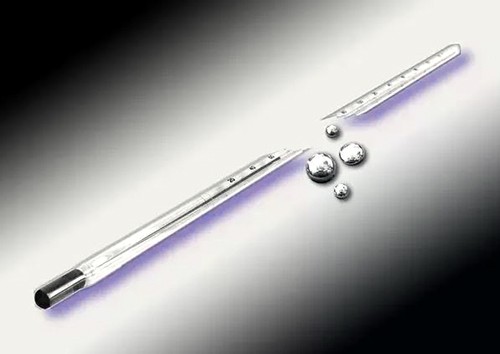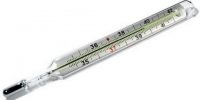Most metals are good conductors of heat and they are solids at room temperature. Mercury is a good conductor of heat. It is used in thermometers because it has a high coefficient of expansion. Its stage indicates the temperature as rapidly as potential and perfectly. Mercury is the only one in a liquid state at room temperature. It will not enlarge when it solidifies, therefore, it doesn’t fracture the glass tube of the thermometer.
In a mercury thermometer, a glass tube is filled with mercury and a usual temperature scale is marked on the tube. With changes in temperature, the mercury expands and contracts and the temperature can be read from the scale. It also has a high boiling point which makes it very suitable to measure higher temperatures.
Causes of Mercury used in Thermometer –
Mercury thermometers can be used to decide the body, liquid, and vapor temperature. These thermometers are used in households, laboratory experiments, and industrial applications. Unfortunately, mercury is toxic and it is replaced almost everywhere.
Mercury thermometers are used in: power plants and piping; chemical tanks; heating and cooling equipment; canneries; ships; paint kettles etc.
Mercury is used in a thermometer because it has a lot of advantages. The advantages of using mercury in a thermometer are as follows:
- Mercury is a good conductor of heat. So mercury level indicates the temperature as quickly as possible and accurately.
- Mercury is available in pure form.
- Mercury is opaque and bright, so the movement of mercury inside the capillary tube is easily visible.
- Mercury does not stick to the glass surface. So it can move freely inside the capillary glass tube.
- Expansion of mercury is uniform along the whole range of temperature. So it gives the correct temperature.
- for a small change of temperature, the expansion of mercury is quite large. Hence it is convenient to make marks on the thermometer surface.
- The freezing point of mercury is – 39oC and the boiling point is 357oC, So for a long span, mercury remains in the liquid form.
- Mercury is less volatile. So a small amount of mercury vapor which remains above the liquid mercury in the thermometer does not hinder the rise and fall of mercury.
- Mercury has much better conductivity and expands quickly, and thus indicates a temperature adjust swiftly.
- Mercury does not damp glass, this leads to an erroneous reading when the thread is falling.
- Mercury is not easily vaporized even at low temperatures.
- It is a metal, so it’s a good conductor of heat. This means that it reacts quickly to changes in temperature.
- The increase of mercury is steady or linear to the changes of the heat, except for actual high temperature.
- Mercury boils at 357°C, so, it can, therefore, be used to measure higher temperatures. However, it freezes at – 39 Celsius, so Mercury cannot be used below this temperature.
Mercury thermometers are reasonably priced, durable and perfect. However, they present many safety and environmental hazards. Their use is gradually more being restricted to industrial and technical applications, as safety and environmental issues are demanding stricter laws on the removal of products containing mercury. Mercury is particularly harmful to fetuses, infants and children.














